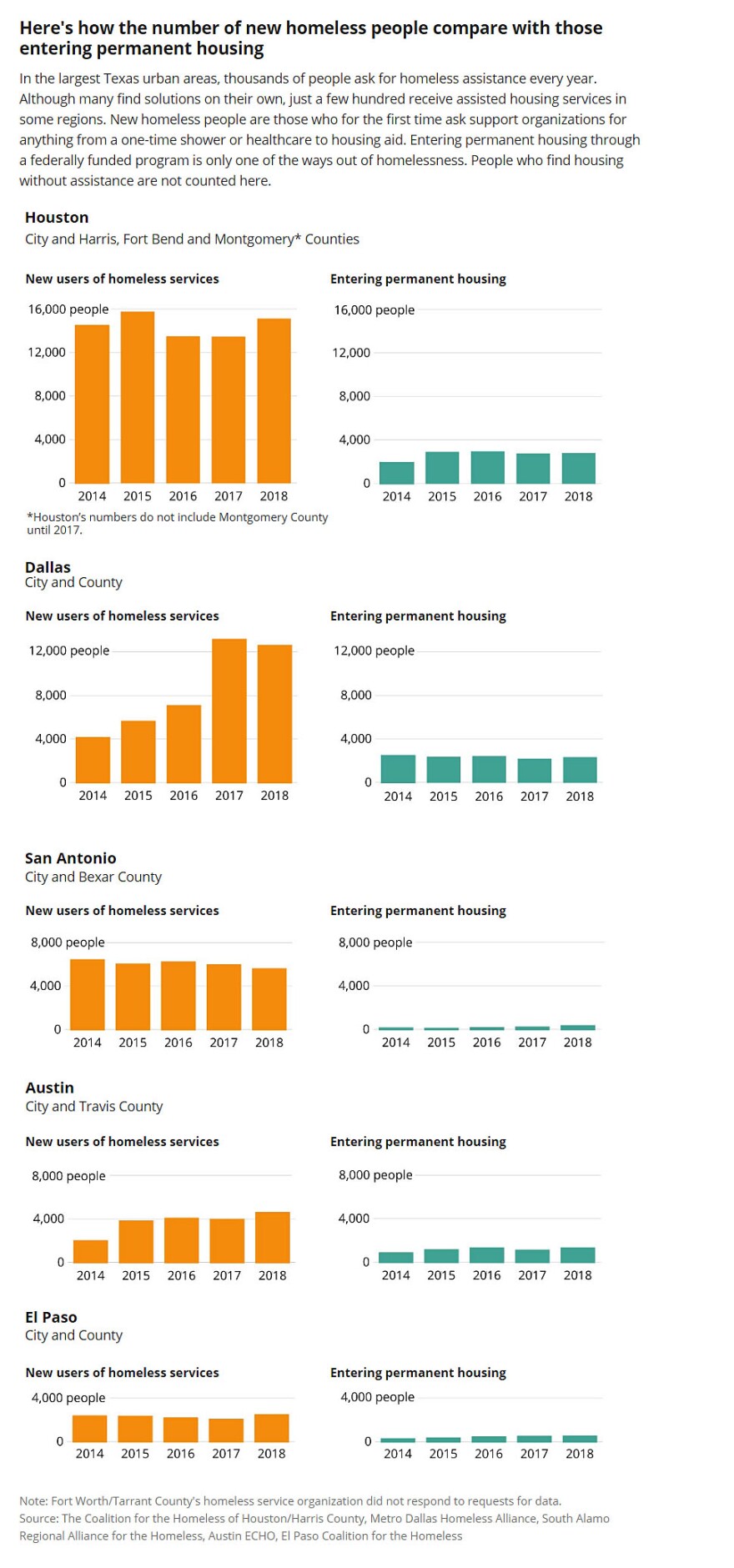Austin leaders and state officials for months have sparred over how to manage homelessness and support Texans without homes. After the Austin City Council softened its regulations on panhandling, sitting and sleeping in public areas, Gov. Greg Abbott criticized local leaders, cleared homeless encampments under highways and opened up a state-owned plot of land in Montopolis for people experiencing homelessness to stay in.
But the governor barely spoke about other Texas cities and their struggles with homelessness. The Dallas and Houston areas last year saw twice as many new people ask for homeless-related services than the Austin area did.
Agencies across the country count the number of people experiencing homelessness at the end of each January. In Texas this year, organizations and volunteers counted 25,848 people experiencing homelessness. About 43% of those people lived on the streets. Although the Houston metropolitan area is the most populated region in the state, the Dallas region saw a larger homeless population. While the Austin region had the fourth largest homeless population, it had the highest share of homeless residents not living with any kind of shelter.

Counting people experiencing homelessness on a specific day can be difficult: While counts of people in shelters are reliable, people on the streets move or can actively avoid contact with volunteers. Weather conditions might also impact how easy it is to spot them. The Texas Tribune also asked regional homelessness organizations for data on individuals that, for the first time, requested homelessness-related assistance. This could be anything from one shower to an actual home or healthcare services. Agencies also provided the numbers of people that received permanent housing through the U.S. Department of Housing and Urban Development, assistance that is typically dedicated to chronically homeless people.
“We believe 76% of the people that come to our system self-resolve and don’t come back for services,” said Ana Rausch, vice president of Program Operations at Houston’s Coalition for the Homeless.

In San Antonio, for example, the regional homeless organization said 3,196 people in 2018 secured a permanent place to stay, from living with a friend to finding a nursing home. Only 302 people secured a place through the assisted housing programs funded by HUD.
Carl Falconer, president and CEO of the Metro Dallas Homeless Alliance, said that area's population boom and the lack of affordable housing spurred the increase in people asking for assistance.
“That comes with more demand for housing, prices go up and people get pushed out," Falconer said.

As is the case nationally, more men than women in Texas experience homelessness. Although the reasons are not clear, research suggests that men might be more prone to risky behaviors, including drinking and using drugs. A previous study showed that women experiencing homelessness had less frequent histories of substance abuse, incarceration, and felony conviction.
According to the Texas Homeless Network, black people are disproportionately affected by homelessness in the state and in the country.
“It's not a surprise that people of color have greater obstacles and less opportunity in our society,” said Eric Samuels, the group's president and CEO. “Greater obstacles and less opportunity result in a smaller margin of ‘error.’ So, minor catastrophic events in our lives that many of us deal with after relatively small struggles result in truly catastrophic outcomes for those without the economic and support system cushions.”
Meanwhile, Hispanic residents are underrepresented among homeless people. That may have to do with family or friends offering shelter and food when someone goes through a rough patch.
“If you talk to people in San Antonio, they may be actually homeless, but they're staying with a tía or with a primo,” said Brenda Mascorro, executive director of the South Alamo Regional Alliance for the Homeless. “So they don't consider themselves homeless, but they're absolutely definitely homeless, because they don't have a residence.”




